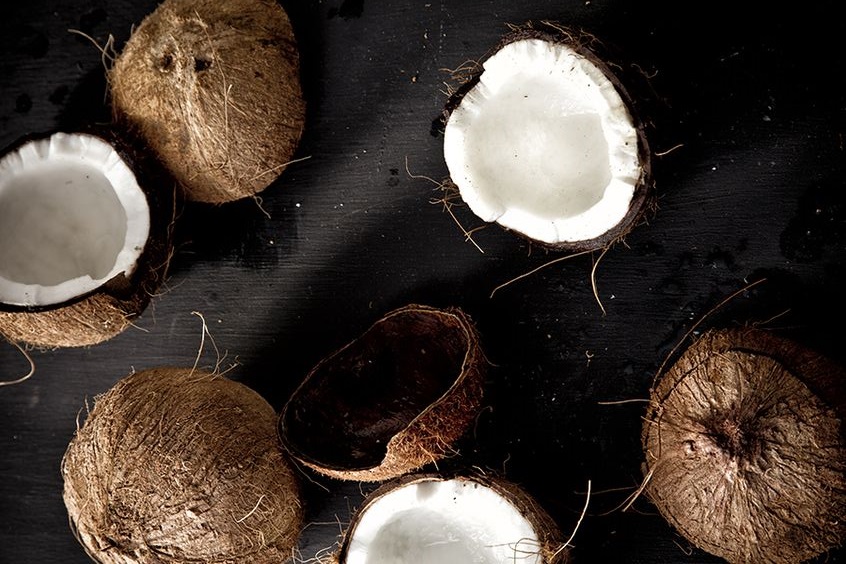Welcome to a new chapter in Blooness guidewhere we will learn all the benefits of coconutThis underrated fruit can be eaten on its own or as an oil. We're going to find out just how this food contains nutritional treasuresand thus become aware of the fact that it is - wrongly - very rarely consumed, especially in the West.
Table of contents
Hide- 1.Introduction
- 2.What you will learn in this content
- 3.Nutritional characteristics of coconut
- 4.A reminder of fatty acids
- 5.A reminder of the importance of saturated fats
- 6.1st conclusion: coconut oil is one of the best sources of saturated fat
- 7.Medium-chain triglycerides (MCT)
- 8.Coconut oil is rich in polyphenols
- 9.Coconut is one of the least sweet fruits available.
- 10.Coconut milk, coconut cream and vegetable coconut drink
- 11.Coconut water
- 12.About cooking coconut oil
- 13.How much coconut should I eat?
- 14.Conclusion about coconut
A quick survey shows that very few people eat coconutwhether in oil or raw fruit form. Most people with a standard diet, who aren't necessarily interested in the superpowers that nutrition can unlock if studied in theory and tested in various forms in practice, are likely to be taken aback if you report that you regularly consume coconut, because there's no particular reason to consume this exotic food, given its exotic nature and the fact that we're not used to eating it, except exceptionally in sweet preparations, to our great delight.
Of course, the intensive cultivation of coconuts, and their importation into countries where they are not grown, raises a number of ecological questions. But in terms of health, this fruit is no less important a nutritional superfoodand we're going to find out here why and how it can be used to improve health, vitality and waist size.
Introduction
As you probably already know, the aim of this guide is to provide you with the most comprehensive range of tools for taking control of your healthand, to take an image, provide the best fuel for your body so that he can give the best of himself.
To unlock this vitality, we can go through food low-carb high fatas most of our ancestors were able to practice it by consuming mainly proteins and fats animal products and, to a lesser extent, foods rich in carbohydrates (potato, parsnip, sweet potato, basmati rice), pulsesbuckwheat, etc.). Once adapted to the modern world, this format can be adapted as follows:
This content is part of the guide Blooness, the guide to the ideal human diet, the summary of which you can find here 🌱🥑
- a first meal rich in proteins lipids and low GI carbohydrates, such as eggs or cheese, accompanied by two slices of buckwheat, spelt or rye bread, olive oil and possibly avocado;
- a second meal rich in protein and low-GI carbohydrates, such as chicken, accompanied simply by a good portion of potatoes and some vegetables or a salad;
- a rather light dinner, rich in easily-assimilable proteins and easily-assimilable fats, such as fish (sometimes lean, sometimes fatty), a small salad and flaxseed oil;
- and possibly a snack of fruit or cereal. oilseeds or a Greek yoghurt or a square of dark chocolate, if you're feeling hungry or depending on your goals.
These are examples, and the foods are all interchangeable with other foods from the same family, and the idea is not to make identical meals every day either.
We can also adopt a "Mediterranean" diet blue zones "compatibleIn other words, a more diversified diet, as made possible by the advent of agriculture in the Neolithic era, and more recently by mass distribution, but still based on raw foods, and with an adapted and balanced distribution of the foods we eat. macronutrients - proteins, lipids and carbohydrates - as well as an intake of fibers adapted, sometimes even dominated by carbohydrates and a minority of lipids, but with high-quality carbohydrates. In the Mediterranean (or blue zones, which refers, for example, to the Okinawan diet), you can significantly increase your carbohydrate intake since it comes from healthy, unprocessed foods such as oven-baked root vegetables, a few fruit, a few cereals à glycemic index moderate.
French-speaking subscribers will receive the newsletter in French, and all others will receive an English version.
You can also alternate periods of low-carb high-fat over several days and, if necessary, replenish glycogen storesThis is achieved by eating one or two carbohydrate-rich meals, every 4 or 5 days for example, especially when energy levels are low, and always from carefully selected foods, excluding, of course, pleasure meals and outings of all kinds.
Another option is to do without carbohydrates altogether and provide its energy through lipids, via pure food ketogenicwhich can also be done over periods of several weeks or months, and not necessarily over a few days, as this would prevent you from taking full advantage of the ketosisexcept possibly for certain high-level athletes, but that's another subject.
All of this has already been described at length in this guide, and in the end, whatever the food format adopted, there are just such things as three flagship foods that are resolutely adapted to these three dietary modes, and which constitute a kind of "game changer" on the metabolic and hormonal levels. These three superfoods are the olive (and its oil), which we've already covered, the avocado, which we've also covered, and the coconut, which we'll cover today.
You will note that these three foods are fruitsBut these are totally atypical fruits, due to their nutritional composition, mainly lipids, not sugars. In fact, these are fresh oleaginous fruits, which complement the dried oleaginous fruits and oilseeds already covered above.
Coconuts, like avocados and olives, are among the most nutritious foods in the world. Superfoods typical of Blue ZonesThese are areas where healthy life expectancy is at an all-time high. And it is, just like the other two fruits, but also like eggplants, tomatoes, zucchinis and peppers, a kind of "fruiting vegetablewhich can be used for both savoury and sweet dishes, and which are all compatible with a Mediterranean diet.
And, as if that weren't enough, coconut, like the aforementioned foods, is a typical food of the ketogenic diet and the low-carb high-fat diet. In fact, it is in this dietary context and by the " keto "Coconut has become particularly popular in recent years, as has avocado.
The power of coconut, is that it is just as effective in a carbohydrate-rich diet as in a predominantly lipid diet.This is also the case for avocados and olives.
Yet from a European perspective, coconut remains an exotic food. The coconut palm originates from the oceanic continent, and the world's main producers of this fruit, which grows on the coastal plains of tropical regions in humid environments, are Indonesia, the Philippines and India.
This is the very essence of this guide, which was originally designed to combining the best eating habits and ingredients from the four corners of the globeIn this way, we can make the most of these different ways of eating, and reach a kind of dietary ideal for health, longevity, vitality and waistline.
Obviously, all populations are different, and not all individuals are alike in every way. Some people are better suited to consuming certain ingredients than others, and the simplest thing to do is to test and get to know each other. But by bringing together the best possible foods - those which, by observation at least, or by cause and effect at best, have shown convincing results in terms of health and life expectancy - we can hope to move towards this ideal, without reaching it, for there is no question here of seeking a sacrosanct optimal that would make us rigid in terms of eating and behavioral habits, but rather approach a lifestyle that is as effective as possible most of the time, to make life more pleasant and functional for as long as possible.
Although coconut is not native to the region where you live, and it's true that it raises ecological questions (no more so than other widely consumed foods, in fact), it is nonetheless completely in line with this quest for optimized nutrition, since it has been identified as a superfood, whether in fruit or oil form. The idea is not to abuse it, but to adopt it in small or large doses, depending on your chosen eating habits.
What you will learn in this content
- How to interpret the nutritional profile coconut?
- Coconut is very high in saturated fats, how it can be good for your health ?
- What is a fatty acid strictly speaking?
- What is a saturated fatty acid?And what's the difference between monounsaturated and polyunsaturated fatty acids?
- What impact does this have on the food preservationand on cooking mode ?
- What is a special type of fatty acid found almost exclusively in coconuts which makes coconut oil a superb energy provider brain and body?
- Visit variations on coconut - yoghurt, water and coconut milk - are they good for you?
- Which cooking method with coconut oil?
- How much coconut according to which diet (ketogenic, low-carb, Mediterranean)?
In this content is reserved for Blooness membersWe're going to take a closer look at coconut, and this unusual fruit will no longer hold any secrets for you.
The rest of this premium content is reserved entirely for Blooness membersand is available in the members' area in both text and audio format (almost 1h30 of audio content).
Join

